

Flickr (IPS Application Layer) SMTP (Simple Mail Transfer Protocol) Security (5,6,7 IPS App Layer) SSH (Secure Shell) OpenSSL. TSL (Transport Layer Security) SSL (Secure Sockets Layer) Network Managment (5, 6, 7 Application Layer) Web pages. HTTP (Hyper Text Protocol) File systems. Lightweight Directory Access Protocol. The Lightweight Directory Access Protocol (LDAP; /ˈɛldæp/) is an open, vendor-neutral, industry standard application protocol for accessing and maintaining distributed directory information services over an Internet Protocol (IP) network.[1] Directory services play an important role in developing intranet and Internet applications by allowing the sharing of information about users, systems, networks, services, and applications throughout the network.[2] As examples, directory services may provide any organized set of records, often with a hierarchical structure, such as a corporate email directory.
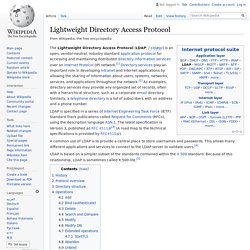
Similarly, a telephone directory is a list of subscribers with an address and a phone number. LDAP is specified in a series of Internet Engineering Task Force (IETF) Standard Track publications called Request for Comments (RFCs), using the description language ASN.1. A common use of LDAP is to provide a central place to store usernames and passwords.
Addresses. DHCP (Dynamic Host Configuration Protocol)-IPS Applicatoin Layer. DNS (Domain Name System) Routing. Routing (5, 6 & 7 IPS Application Layer) SSH (Secure Shell) RIP (Routing Information Protocol) BGP (Borde Gateway Protocol) Session Initiation Protocol. SIP works in conjunction with several other application layer protocols that identify and carry the session media.
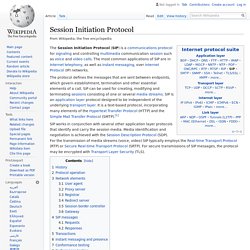
Media identification and negotiation is achieved with the Session Description Protocol (SDP). For the transmission of media streams (voice, video) SIP typically employs the Real-time Transport Protocol (RTP) or Secure Real-time Transport Protocol (SRTP). For secure transmissions of SIP messages, the protocol may be encrypted with Transport Layer Security (TLS). History[edit] The protocol was designed with the vision to support new multimedia applications. SIP is distinguished by its proponents for having roots in the Internet community rather than in the telecommunications industry. Protocol operation[edit] SIP employs design elements similar to the HTTP request/response transaction model.[8] Each transaction consists of a client request that invokes a particular method or function on the server and at least one response. Category:Application layer protocols. This category includes protocols from the Application Layer of the Internet Protocol Suite as well as the protocols of OSI Layer 7.

The Application Layer of the Internet Protocol Suite includes Session Layer protocols and Presentation Layer protocols from OSI. Subcategories This category has the following 32 subcategories, out of 32 total. Pages in category "Application layer protocols" The following 154 pages are in this category, out of 154 total. XMPP. Official logo Extensible Messaging and Presence Protocol (XMPP) is a communications protocol for message-oriented middleware based on XML (Extensible Markup Language).[1] The protocol was originally named Jabber,[2] and was developed by the Jabber open-source community in 1999 for near real-time, instant messaging (IM), presence information, and contact list maintenance.
Designed to be extensible, the protocol has also been used for publish-subscribe systems, signalling for VoIP, video, file transfer, gaming, Internet of Things applications such as the smart grid, and social networking services. The Internet Engineering Task Force (IETF) formed an XMPP working group in 2002 to formalize the core protocols as an IETF instant messaging and presence technology. The XMPP Working group produced four specifications (RFC 3920, RFC 3921, RFC 3922, RFC 3923), which were approved as Proposed Standards in 2004. History[edit] Strengths[edit] Decentralization Open standards History. Telnet. Telnet is a network protocol used on the Internet or local area networks to provide a bidirectional interactive text-oriented communication facility using a virtual terminal connection.

User data is interspersed in-band with Telnet control information in an 8-bit byte oriented data connection over the Transmission Control Protocol (TCP). Telnet was developed in 1968 beginning with RFC 15, extended in RFC 854, and standardized as Internet Engineering Task Force (IETF) Internet Standard STD 8, one of the first Internet standards. Historically, Telnet provided access to a command-line interface (usually, of an operating system) on a remote host. Most network equipment and operating systems with a TCP/IP stack support a Telnet service for remote configuration (including systems based on Windows NT). Simple Network Management Protocol. Simple Network Management Protocol (SNMP) is an Internet-standard protocol for collecting and organizing information about managed devices on IP networks and for modifying that information to change device behavior.
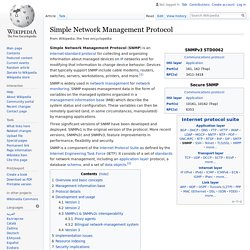
Devices that typically support SNMP include cable modems, routers, switches, servers, workstations, printers, and more.[1] SNMP is widely used in network management for network monitoring. SNMP exposes management data in the form of variables on the managed systems organized in a management information base (MIB) which describe the system status and configuration. These variables can then be remotely queried (and, in some circumstances, manipulated) by managing applications. Three significant versions of SNMP have been developed and deployed. Real Time Streaming Protocol. The Real Time Streaming Protocol (RTSP) is a network control protocol designed for use in entertainment and communications systems to control streaming media servers.
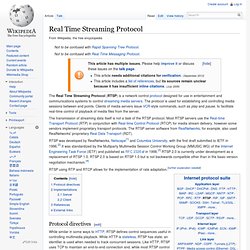
The protocol is used for establishing and controlling media sessions between end points. Clients of media servers issue VCR-style commands, such as play and pause, to facilitate real-time control of playback of media files from the server. The transmission of streaming data itself is not a task of the RTSP protocol. Real-time Transport Protocol. The Real-time Transport Protocol (RTP) defines a standardized packet format for delivering audio and video over IP networks.
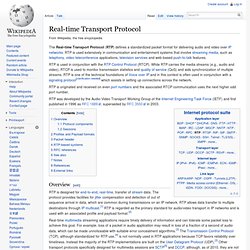
RTP is used extensively in communication and entertainment systems that involve streaming media, such as telephony, video teleconference applications, television services and web-based push-to-talk features. RTP is used in conjunction with the RTP Control Protocol (RTCP). While RTP carries the media streams (e.g., audio and video), RTCP is used to monitor transmission statistics and quality of service (QoS) and aids synchronization of multiple streams. RTP is one of the technical foundations of Voice over IP and in this context is often used in conjunction with a signaling protocol[clarification needed] which assists in setting up connections across the network.
RTP is originated and received on even port numbers and the associated RTCP communication uses the next higher odd port number. Overview[edit] Open Network Computing Remote Procedure Call. ONC RPC was described in RFC 1831, published in 1995.

RFC 5531, published in 2009, is the current version. Authentication mechanisms used by ONC RPC are described in RFC 2695, RFC 2203, and RFC 2623. In 2009, Sun relicensed the ONC RPC code under the standard 3-clause BSD license[1] and then reconfirmed by Oracle Corporation in 2010 following confusion about the scope of the relicensing.[2] ONC is considered "lean and mean", but has limited appeal as a generalized RPC system for WANs or heterogeneous environments[citation needed]. Network News Transfer Protocol. As local area networks and Internet participation proliferated, it became desirable to allow newsreaders to be run on personal computers connected to local networks.
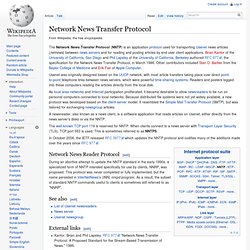
Because distributed file systems were not yet widely available, a new protocol was developed based on the client-server model. It resembled the Simple Mail Transfer Protocol (SMTP), but was tailored for exchanging newsgroup articles. A newsreader, also known as a news client, is a software application that reads articles on Usenet, either directly from the news server's disks or via the NNTP.
The well-known TCP port 119 is reserved for NNTP. When clients connect to a news server with Transport Layer Security (TLS), TCP port 563 is used. In October 2006, the IETF released RFC 3977 which updates the NNTP protocol and codifies many of the additions made over the years since RFC 977. Post Office Protocol. Overview[edit] POP supports simple download-and-delete requirements for access to remote mailboxes (termed maildrop in the POP RFC's).[3] Although most POP clients have an option to leave mail on server after download, e-mail clients using POP generally connect, retrieve all messages, store them on the user's PC as new messages, delete them from the server, and then disconnect.

Other protocols, notably IMAP, (Internet Message Access Protocol) provide more complete and complex remote access to typical mailbox operations. In the late 90's and early 2000's, fewer Internet Service Providers (ISPs) supported IMAP due to the storage space that was required on the ISP's hardware. Contemporary e-mail clients supported POP, then over time popular mail client software added IMAP support. A POP3 server listens on well-known port 110. Media Gateway Control Protocol. Internet Message Access Protocol. Internet Message Access Protocol (IMAP) is a protocol for e-mail retrieval and storage developed in 1986 by Mark Crispin in 1986 at Stanford University as an alternative to POP.
IMAP unlike POP, specifically allows multiple clients simultaneously connected to the same mailbox, and through flags stored on the server, different clients accessing the same mailbox at the same or different times can detect state changes made by other clients. Osi. 7. OSI Application Layer. 6. OSI Presentation Layer. 5. OSI Session Layer.